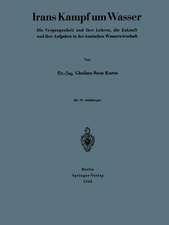Microbial and Enzymatic Degradation of Wood and Wood Components: Springer Series in Wood Science
Autor Karl-Erik L. Eriksson, Robert A. Blanchette, Paul Anderen Limba Engleză Paperback – 14 mar 2012
Din seria Springer Series in Wood Science
- 18%
 Preț: 1543.84 lei
Preț: 1543.84 lei - 23%
 Preț: 2062.71 lei
Preț: 2062.71 lei - 18%
 Preț: 1824.32 lei
Preț: 1824.32 lei - 18%
 Preț: 2093.60 lei
Preț: 2093.60 lei - 24%
 Preț: 817.70 lei
Preț: 817.70 lei - 18%
 Preț: 1225.16 lei
Preț: 1225.16 lei - 18%
 Preț: 3294.30 lei
Preț: 3294.30 lei - 18%
 Preț: 948.29 lei
Preț: 948.29 lei - 18%
 Preț: 1222.31 lei
Preț: 1222.31 lei - 18%
 Preț: 952.26 lei
Preț: 952.26 lei - 15%
 Preț: 643.34 lei
Preț: 643.34 lei - 18%
 Preț: 1122.87 lei
Preț: 1122.87 lei - 18%
 Preț: 1020.30 lei
Preț: 1020.30 lei - 24%
 Preț: 786.00 lei
Preț: 786.00 lei - 20%
 Preț: 569.47 lei
Preț: 569.47 lei - 15%
 Preț: 638.89 lei
Preț: 638.89 lei - 15%
 Preț: 636.30 lei
Preț: 636.30 lei - 15%
 Preț: 635.31 lei
Preț: 635.31 lei - 18%
 Preț: 883.44 lei
Preț: 883.44 lei - 18%
 Preț: 1004.67 lei
Preț: 1004.67 lei - 18%
 Preț: 894.03 lei
Preț: 894.03 lei - 15%
 Preț: 658.70 lei
Preț: 658.70 lei - 15%
 Preț: 641.53 lei
Preț: 641.53 lei - 18%
 Preț: 950.84 lei
Preț: 950.84 lei - 18%
 Preț: 783.35 lei
Preț: 783.35 lei - 15%
 Preț: 645.79 lei
Preț: 645.79 lei - 24%
 Preț: 880.78 lei
Preț: 880.78 lei -
 Preț: 388.13 lei
Preț: 388.13 lei - 18%
 Preț: 780.82 lei
Preț: 780.82 lei - 18%
 Preț: 891.65 lei
Preț: 891.65 lei
Preț: 646.43 lei
Preț vechi: 760.50 lei
-15% Nou
Puncte Express: 970
Preț estimativ în valută:
123.73€ • 127.51$ • 104.46£
123.73€ • 127.51$ • 104.46£
Carte tipărită la comandă
Livrare economică 01-15 martie
Preluare comenzi: 021 569.72.76
Specificații
ISBN-13: 9783642466892
ISBN-10: 3642466893
Pagini: 420
Ilustrații: IX, 407 p.
Dimensiuni: 155 x 235 x 22 mm
Greutate: 0.59 kg
Ediția:Softcover reprint of the original 1st ed. 1990
Editura: Springer Berlin, Heidelberg
Colecția Springer
Seria Springer Series in Wood Science
Locul publicării:Berlin, Heidelberg, Germany
ISBN-10: 3642466893
Pagini: 420
Ilustrații: IX, 407 p.
Dimensiuni: 155 x 235 x 22 mm
Greutate: 0.59 kg
Ediția:Softcover reprint of the original 1st ed. 1990
Editura: Springer Berlin, Heidelberg
Colecția Springer
Seria Springer Series in Wood Science
Locul publicării:Berlin, Heidelberg, Germany
Public țintă
ResearchCuprins
1 Morphological Aspects of Wood Degradation by Fungi and Bacteria.- 1.1 Morphology of Wood and Wood Components.- 1.2 Wood Degradation by White-Rot Fungi.- 1.3 Wood Degradation by Brown-Rot Fungi.- 1.4 Wood Degradation by Soft-Rot Fungi.- 1.5 Wood Degradation by Bacteria.- 2 Biodegradation of Cellulose.- 2.1 The Structure and Biosynthesis of Cellulose.- 2.2 Cellulolytic Fungi.- 2.3 Cellulolytic Enzymes.- 2.4 Assay of Enzymes Participating in Cellulose Degradation.- 2.5 Cellulose Degradation by White-Rot, Brown-Rot, Soft-Rot, and Anaerobic Fungi.- 2.6 Cellulose Degradation by Bacteria.- 2.7 Regulation of Cellulase Synthesis.- 2.8 Synergistic Mechanisms Involved in Cellulose Degradation.- 2.9 Examples of Applications of Cellulolytic Microorganisms and Their Enzymes.- 3 Biodegradation of Hemicelluloses.- 3.1 The Structures of Hemicelluloses.- 3.2 Biosynthesis of Hemicelluloses.- 3.3 Xylanolytic Enzymes.- 3.4 Mannan-Degrading Enzymes.- 3.5 Examples of Applications of Hemicellulolytic Organisms and Their Enzymes.- 4 Biodegradation of Lignin.- 4.1 Biosynthesis and Structure of Lignin.- 4.2 Lignin Preparations and Methods for Studying Lignin Biodegradation.- 4.3 Lignin Degradation by White-Rot Fungi.- 4.4 Chemistry of Lignin Degraded by White-Rot Fungi.- 4.5 Biochemistry of Lignin Degradation.- 4.6 Metabolism of Monomeric Lignin-Related Compounds.- 4.7 Lignin Degradation by Brown-Rot, Soft-Rot, and Other Fungi.- 4.8 Lignin Degradation by Bacteria.- 4.9 Potential Applications of White-Rot Fungi.- 4.10 Some Examples of Future Research Possibilities.- References.






















